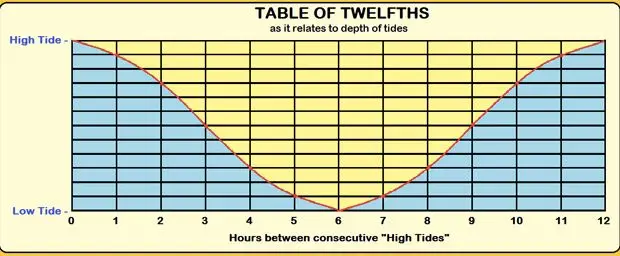
Tide and the rule of 12
The Rule of Twelfths is a simplified method used by sailors to estimate the rise and fall of tides throughout a tidal cycle, particularly in areas with semi-diurnal tides (two high and two low tides each day). This rule assumes that tidal changes follow a sinusoidal pattern, meaning that the water level changes more rapidly at mid-tides and more slowly near high and low tides. (See Tidal Planning)
Understanding the Rule of Twelfths
The tidal cycle typically lasts about 6 hours between low tide and high tide (or vice versa), and the Rule of Twelfths divides this period into six equal time intervals, each lasting approximately 1 hour. The rule is based on the idea that the tide moves in twelfths of the total range (the difference between high and low tide) during each hour of the tidal cycle.
How It Works:
The total rise or fall of the tide is divided into 12 parts over a 6-hour period. The amount of water that rises or falls in each hour is distributed as follows:
- 1st hour: 1/12 of the total tidal range
- 2nd hour: 2/12 of the total tidal range
- 3rd hour: 3/12 of the total tidal range
- 4th hour: 3/12 of the total tidal range
- 5th hour: 2/12 of the total tidal range
- 6th hour: 1/12 of the total tidal range
This means that the water level changes most rapidly in the middle of the tidal cycle (hours 3 and 4) and slowly at the beginning and end of the cycle (hours 1 and 6).
Example of the Rule of Twelfths in Action:
Let’s assume:
- Tidal range (the difference between high and low tide): 6 meters.
- You calculate the rise of the tide over 6 hours from low to high tide.
- First hour:
- Rise = 1/12×6=0.5 meters
- Second hour:
- Rise = 2/12×6=1.0 meter
- Third hour:
- Rise = 31/2×6=1.5 meters
- Fourth hour:
- Rise = 31/2×6=1.5 meters
- Fifth hour:
- Rise = 21/2×6=1.0 meter
- Sixth hour:
- Rise = 11/2×6=0.5 meters
Total Rise After Each Hour:
- After 1 hour: 0.5 meters
- After 2 hours: 1.5 meters (0.5 + 1.0)
- After 3 hours: 3.0 meters (1.5 + 1.5)
- After 4 hours: 4.5 meters (3.0 + 1.5)
- After 5 hours: 5.5 meters (4.5 + 1.0)
- After 6 hours: 6.0 meters (5.5 + 0.5)
Why Use the Rule of Twelfths?
- Tidal Height Estimation: Sailors can use the Rule of Twelfths to estimate how much the tide will rise or fall during the next hour or over the entire tidal cycle. This is helpful when navigating in shallow waters or when timing harbour entrances.
- Tidal Stream (Current): Since tidal currents are strongest at mid-tide and slowest at high and low water, the Rule of Twelfths can also approximate how tidal currents may change during the cycle.
- Planning for power consumption: If you need to travel from A to B, using the Rule of Twelfths is more economical (or quicker). You can take advantage of the knowledge that you will have a robust current assisting you if you decide to travel during those hours with the most substantial current.
When the Rule of Twelfths Is Useful:
- Entering and Leaving Ports: Estimating whether there will be enough water in a channel or harbour.
- Anchoring: Knowing how much water will be under your keel at different times.
- Crossing Sandbars: Timing crossings of shallow bars with rising tides.
- Full consumption: Time when it is more efficient to travel with tidal assistance.
- Safety when docking: In strong tidal areas, plan your docking manoeuvres at the top and bottom of the scale where tidal forces are least prominent.
However, this rule is a rough estimate and does not account for all variations (like geographic influences or unusual tidal patterns). It works best in areas where the tide closely follows a sinusoidal pattern.

NAVIGATION RULES CLINIC + BASIC SAIL TRIM COURSE
Author
-

Rene is a keelboat instructor and sailing coach in the Mandurah area WA. He is also the author of several books about sailing including "The Book of Maritime Idioms" and "Renaming your boat".
View all posts


